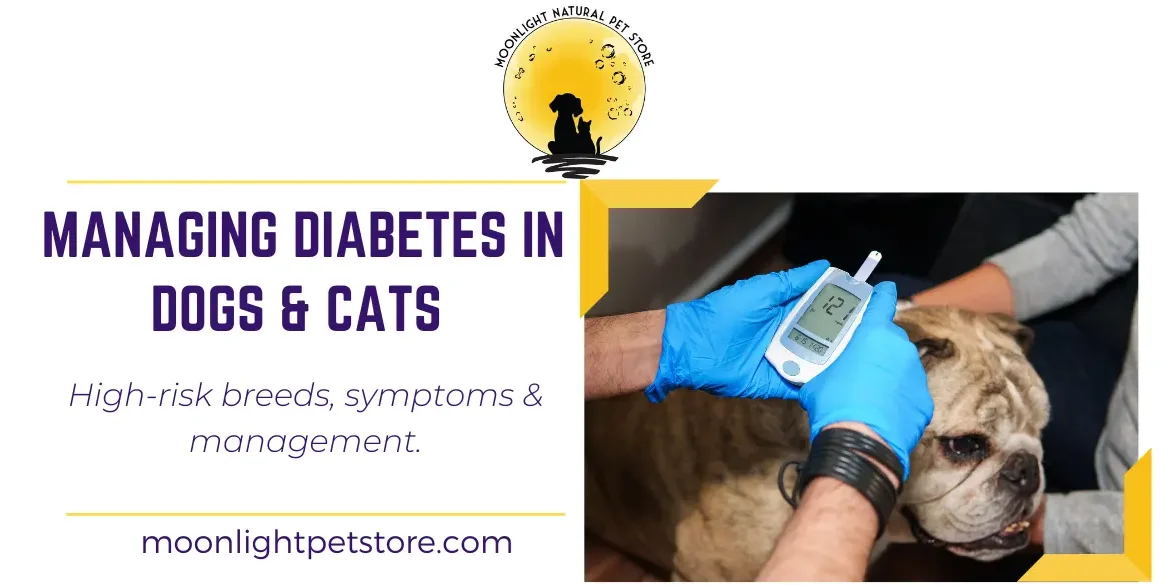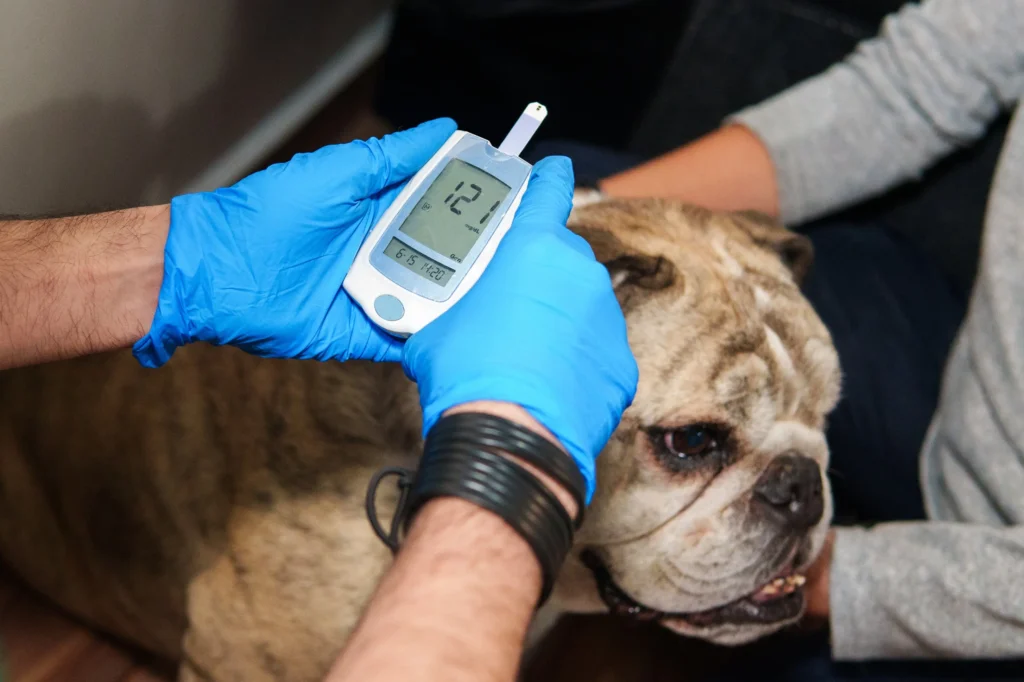
Diabetes In Dogs & Cats: Symptoms, Treatment & High-Risk Breeds
What Causes Pet Diabetes?
For most pet parents, diabetes in dogs & cats seems to just sneak up on them. Diabetes mellitus is a chronic endocrine disorder that affects a pet’s ability to regulate blood sugar (glucose) levels effectively. In a healthy dog or cat, the pancreas produces insulin, a hormone responsible for transporting glucose from the bloodstream into cells, where it is used for energy. When this process is disrupted—either because
- the body stops producing insulin or
- becomes resistant to insulin/ doesn’t use it well
—blood sugar levels remain elevated. Over time, this can lead to serious health complications affecting various organ systems.
While dogs have a greater physiological tolerance for carbohydrates compared to obligate carnivores like cats, this doesn’t imply that a high-carbohydrate diet is ideal for them.
A diet rich in refined carbohydrates can stress a dog’s insulin-regulation system, making it harder for the body to maintain stable glucose levels. A diet rich in quality animal proteins, healthy fats, and low-glycemic vegetables—supports better metabolic health and minimizes the risk of insulin resistance over time.
How Common is Diabetes in Dogs and Cats?
Diabetes in pets is more prevalent than many pet owners realize.
According to data from Merck Animal Health, approximately 1 in 300 dogs will develop diabetes during their lifetime. The incidence is even higher in cats, with around 1 in 230 being diagnosed. 1
These statistics highlight the growing need for awareness and proactive management of this disease, especially given the increasing prevalence of processed pet foods and sedentary lifestyles among companion animals.
Type 1 vs Type 2 Diabetes in Dogs & Cats
Diabetes in dogs & cats is not fully understood. We will use the human equivalence in diabetes to explain what might be happening in pets.
In dogs, diabetes manifests predominantly as Type 1 diabetes, which involves the destruction of insulin-producing beta cells in the pancreas. This form of diabetes is insulin-dependent, meaning the dog will require lifelong insulin injections to manage blood glucose levels. 6
Type 2 diabetes—where the body becomes resistant to insulin despite its production—is more common in cats and rarely diagnosed in dogs. However, in cases of chronic obesity or prolonged insulin resistance, some dogs may exhibit characteristics like Type 2 diabetes. 2
Unlike in humans, canine diabetes is often not reversible, but with diligent management—including proper nutrition, exercise, and insulin therapy—many dogs and cats can live long, healthy lives.
Risk Factors of Diabetes in Dogs & Cats
Although diabetes in dogs & cats can develop at any age, it is most diagnosed in:
- Dogs (over 5 years old), with middle-aged and senior dogs being particularly vulnerable. Interestingly, female dogs are nearly twice as likely to develop diabetes compared to males, especially if they are unspayed. 1
- Cats (over 8 years old), with male cats (tendency of male cats to have lower insulin sensitivity values while lean compared to female)11 and obese cats particularly vulnerable. 1, 11
Several other factors seem to significantly increase a cat or dog’s chances of developing diabetes:
- Breed- predisposition to diabetes – several breeds of dogs and cats just are at a higher-risk of getting diabetes.
- Obesity is one of the leading contributors, as excess body fat makes it more difficult for the body’s cells to respond effectively to insulin. This insulin resistance forces the pancreas to work harder until it can no longer keep up with demand.
- Pancreatic diseases, such as pancreatitis, can cause direct damage to the pancreas’ insulin-producing cells. Chronic or repeated episodes of inflammation severely impair the organ’s function, making diabetes a likely consequence.
- Long-term use of corticosteroids, often prescribed to suppress pet allergies, autoimmune conditions, or inflammation, can lead to insulin resistance. Over time, this increases the likelihood of diabetes, especially when combined with other risk factors like obesity or genetic predisposition.
- Cushing’s disease, a hormonal disorder where the body produces excess cortisol, disrupts glucose metabolism and increases the risk of diabetes in affected dogs.
- Poor diet, particularly those based on high-carbohydrate dry kibble, continuously spikes blood sugar levels and contributes to insulin resistance over time. Diets not aligned with a dog’s biological needs could accelerate the path to diabetes, especially when paired with a sedentary lifestyle.
Understanding these risk factors allows pet parents to take proactive steps—such as dietary adjustments, regular exercise, and routine vet check-ups—to minimize their cat’s or dog’s risk of developing diabetes later in life.
Dog Breeds at Higher Risk of Canine Diabetes
Certain dog breeds exhibit a genetic predisposition to developing diabetes. According to research, Samoyeds are 12 times more likely to develop diabetes while Australian Terriers are 32 times more likely compared to mixed breeds.7 Other veterinary studies identify additional high-risk breeds, including:
- Cairn Terriers
- Tibetan Terriers
- Miniature Schnauzers
- Poodles
- Keeshonds
- Dachshunds
- Beagles
- Labrador Retrievers
- Pugs
- Yorkshire Terriers
Owners of these breeds should be vigilant for early signs of diabetes, especially as their pet approaches middle age.
Cat Breeds at Higher Risk of Feline Diabetes
Certain cat breeds exhibit a genetic predisposition to developing diabetes. According to research from Sweden, high-risk breeds, included:
- Burmese
- Russian Blue
- Norwegian Forest Cat
- Abyssinian
Owners of these breeds should be vigilant for early signs of diabetes, especially as their pet approaches middle age.
Pancreatitis in Pets: An Overlooked Link to Canine and Feline Diabetes
The pancreas is a vital exocrine and endocrine organ that plays multiple roles in a dog’s digestion and metabolic regulation. It performs three key functions:
- Digestive Enzyme Production: The pancreas secretes enzymes such as amylase (which digests carbohydrates), lipase (which digests fats), and trypsinogen (which digests proteins).
- Neutralizing Stomach Acids: The pancreatic juice contains sodium bicarbonate, which neutralizes stomach acids as they enter the small intestine, protecting the delicate intestinal lining.
- Hormonal Regulation of Blood Glucose: The pancreas produces glucagon (raises blood glucose), insulin (lowers blood glucose), and somatostatin (regulates both), maintaining blood sugar balance.
Pancreatitis, the inflammation of the pancreas, occurs when digestive enzymes become prematurely activated within the pancreas itself, leading to the organ essentially digesting itself and surrounding tissues. Pancreatitis can present as acute (sudden onset with severe symptoms such as vomiting, abdominal pain, and lethargy) or chronic (recurrent, less severe flare-ups with intermittent loss of appetite).
Veterinary medicine has yet to pinpoint a definitive cause of pancreatitis. Dietary indiscretions like high-fat meals are suspected triggers, as are certain medications such as steroids and antibiotics. Chronic pancreatitis can damage the beta cells responsible for insulin production, leading to secondary diabetes. Conversely, existing diabetes can predispose dogs to pancreatitis, making the two conditions a dangerous feedback loop. If a dog develops acute pancreatitis, immediate veterinary attention is required. Diagnostic tests like elevated lipase levels and canine pancreatic lipase immunoreactivity (cPL test)—which is about 75% accurate—help confirm the diagnosis.
How Steroids & Medications Increase Canine Diabetes Risk
While genetics, diet, and underlying conditions like pancreatitis are well-known contributors to diabetes in dogs, the role of medications—particularly corticosteroids (steroids)—is often overlooked. Steroids such as prednisone and dexamethasone are commonly prescribed to suppress inflammatory conditions, allergies, autoimmune diseases, and even certain cancers.
According to a UK study, “Dogs with diabetes mellitus had more than 4 times the risk of exposure to glucocorticoids in the 6 weeks prior diabetes mellitus diagnosis compared to controls.” 5 This means that long-term or high-dose steroid use can significantly increase a dog’s risk of developing diabetes10 as Dr Rehanni stated in her blog.
Steroids can induce a state of insulin resistance by promoting gluconeogenesis (the production of glucose in the liver) and inhibiting the normal function of insulin receptors on cells. This forces the pancreas to overproduce insulin to regulate blood glucose levels. Over time, this persistent demand can exhaust the insulin-producing beta cells in the pancreas, leading to diabetes mellitus. This form of diabetes is often referred to as “iatrogenic diabetes”, meaning it is caused by medical treatment.
In addition to steroids, other classes of drugs have also been linked to an increased risk of diabetes in dogs:
- Progestins: Synthetic hormones sometimes used to manage reproductive issues or certain cancers, can induce insulin resistance like steroids.9
- Diuretics (Thiazides): Used for managing conditions like heart disease, urinary diseases or high blood pressure, diuretics can alter glucose metabolism and electrolyte balance, contributing to diabetes in dogs susceptible.8
- Phenobarbital: A common anti-seizure medication, phenobarbital can affect liver function and glucose regulation with prolonged use.
- Cyclosporine: An immunosuppressant drug used in treating autoimmune diseases or organ transplants, which can impair pancreatic function in rare cases.9
It is important for pet parents and veterinarians to weigh the benefits against the potential risks—especially in breeds predisposed to diabetes or in dogs with a history of pancreatitis or obesity. If steroids or other risk-prone drugs must be used, close monitoring of blood glucose levels, regular veterinary check-ups, and proactive dietary management become even more critical.
Cushing’s Disease & Its Link to Diabetes in Dogs
Cushing’s disease, medically known as hyperadrenocorticism, occurs when a dog’s adrenal glands produce excessive amounts of cortisol—a hormone that plays a vital role in managing stress, metabolism, and immune function. Cushing’s is more common in dogs than cats.
While cortisol is essential for daily physiological processes, persistently high levels can disrupt the body’s ability to regulate blood sugar.
One of the most significant consequences of excess cortisol is the development of insulin resistance.
Diagnosing Cushing’s disease can be challenging because many of its symptoms overlap with those of diabetes and other diseases. Dogs with Cushing’s may exhibit:
- Increased thirst and frequent urination
- An insatiable appetite
- Lethargy or low energy levels
- Thinning fur or noticeable hair loss
- A distended, pot-bellied abdomen
In fact, it’s not uncommon for a dog to be diagnosed with diabetes first, only for further testing to reveal that Cushing’s disease was the underlying cause. When both conditions are present, managing diabetes becomes more complex, as controlling cortisol levels is critical to restoring insulin sensitivity and stabilizing blood sugar.
A thorough veterinary workup, including endocrine testing, is essential for differentiating between primary diabetes and cases where Cushing’s disease is a contributing factor. Early detection allows for more targeted treatment, improving long-term outcomes for the dog.
Symptoms of Diabetes in Dogs & Cats
Symptoms to watch for include
- excessive thirst (polydipsia),
- frequent urination (polyuria),
- sudden weight loss despite a good appetite,
- lethargy, and cloudy eyes—a precursor to diabetic cataracts.

Routine veterinary blood work becomes essential for early detection, particularly if the dog has had episodes of pancreatitis or has a body condition score indicating obesity, both of which are risk factors.
This can be combined with Urinalysis tests and Cushing’s testing to rule out Cushing’s.
What Happens If Pet Diabetes Goes Untreated?
When diabetes in dogs & cats is left unmanaged, persistently high blood sugar levels can cause widespread damage throughout the body. Over time, the excessive glucose in the bloodstream starts to impair vital organs and systems. Complications may include:
- progressive damage to the heart, liver, and kidneys, which can lead to organ failure if not addressed. The immune system also becomes compromised, making diabetic dogs more prone to chronic infections and wounds that heal very slowly, if at all.
- One of the earliest and most visible complications is the development of cataracts, which can lead to partial or complete blindness if blood sugar remains uncontrolled.
- Additionally, uncontrolled diabetes can escalate into Diabetic Ketoacidosis- a life-threatening complication where the body starts breaking down fat for energy, leading to the accumulation of harmful ketones in the bloodstream.
Holistic Treatment of Dog & Cat Diabetes
Treatment starts with knowing whether your pet has Type 1 (likely in certain breed of cats and dogs) or Type 2 diabetes (more likely in cats).

For Type 1 Diabetes in Dogs & Cats
Treatment means ongoing insulin injections subcutaneously with frequency dictated by what your vet instructs you.
- Insulin can be sensitive so proper storage and handling is important.3
- “Normal blood glucose levels in healthy dogs are 80-120 milligrams per decilitre (mg/dl). Most dogs can handle levels going as high as 250 with minimal side effects. Post mealtimes, some dogs may normally go up to 400 but that is a temporary effect. Once blood glucose levels go over 200, glucose will be detectable in the urine.” 3
In both Type 1 & 2 Diabetes in Pets
Dietary management plays a pivotal role in controlling diabetes. A raw diet, particularly one low in carbohydrates and low/moderate in fat, aligns with a dog’s natural metabolic needs. Moisture-rich raw meals help prevent blood sugar spikes and keep the body hydrated, an essential factor since diabetic dogs are prone to dehydration.
- Prescription diets for diabetes have higher fiber, which give your pet the feeling of being fuller and therefore aim to provide weight management. However, the ingredients are not ones we’d recommend or personally feed to our pets.
- Type 2 diabetes may require insulin still as it is the key that convinces cells to uptake glucose.
Given a History of Pet Pancreatitis
It’s advisable to opt for lower-fat, low-glycemic raw diets or gently cooked diets.
These diets are not only lower in fat and carbohydrates but also incorporate a variety of proteins and micronutrients to keep mealtime interesting and nutritionally balanced.
Frequency of Meals for Dogs & Cats with Diabetes
If you’re currently feeding two meals per day, transitioning to three smaller meals (while maintaining the same total daily intake) can help stabilize blood sugar levels throughout the day.
For instance, if a dog requires 0.5 lbs of food daily to maintain a target weight, dividing this into three 0.166 lb meals reduces glycemic fluctuations.
Obesity & Exercise
Obese pets need to lose weight whether it is more frequent walks for dogs or using treats/ teasers to get your cat to run and jump.
Additional Diet Supplementation
To further support pancreatic health, adding digestive enzymes and probiotics can reduce the workload on the pancreas. Supplements like Adored Beast Healthy Gut provide both in a single formulation, aiding digestion and improving nutrient absorption.
- In cats, studies show that overweight cats fed omega-3s had lower insulin levels and might have less risk of diabetes.
- Additionally, natural compounds like Berberine are known to help regulate blood sugar levels by enhancing insulin sensitivity.
Provide Constant Access to Fresh Water to Your Diabetic Pet
This is crucial, as dehydration can exacerbate blood sugar imbalances and strain kidney function.
What to Do if Hypoglycemia in Pets
Lastly, if your dog or cat is very lethargic or sleeping more than usual, they may have hypoglycemia, which is low blood sugar. This can be quite serious and some pets may have tremors or difficulty walking.3
Put honey on their gums and once they are alert, feed them something that will raise their blood sugar levels quickly. Contact your vet.
References
- https://www.merck-animal-health.ca/tools-resources/pet-diabetes/#:~:text=How%20common%20is%20pet%20diabetes,in%20230%20cats1%2C2
- https://www.petmd.com/dog/conditions/endocrine/diabetes-dogs
- Managing canine diabetes https://www.vet.cornell.edu/departments-centers-and-institutes/riney-canine-health-center/canine-health-information/managing-canine-diabetes?
- Assessment of glucocorticoid and antibiotic exposure as risk factors for diabetes mellitus in selected dog breeds attending UK primary-care clinics https://bvajournals.onlinelibrary.wiley.com/doi/10.1002/vetr.2785
- New VetCompass study investigates potential association between exposure to antibiotics and corticosteroids and the development of diabetes mellitus in dogs https://www.rvc.ac.uk/vetcompass/news/new-vetcompass-study-investigates-potential-association-between-exposure-to-antibiotics-and-corticosteroids-and-the-development-of-diabetes-mellitus-in-dogs?
- https://en.wikipedia.org/wiki/Diabetes_in_dogs?
- An Exploratory Association Analysis of the Insulin Gene Region With Diabetes Mellitus in Two Dog Breeds https://pmc.ncbi.nlm.nih.gov/articles/PMC6916661/#:~:text=In%20the%20United%20States%2C%20Samoyeds,United%20Kingdom%20(Fall%20et%20al
- Diuretics Used to Treat Urinary Disease in Animals https://www.merckvetmanual.com/pharmacology/systemic-pharmacotherapeutics-of-the-urinary-system/diuretics-used-to-treat-urinary-disease-in-animals#Loop-Diuretics_v86108767
- Diabetes Mellitus in Dogs and Cats https://www.merckvetmanual.com/endocrine-system/the-pancreas/diabetes-mellitus-in-dogs-and-cats
- A Vet’s Perspective: Why Does My Dog Have Skin Disease https://www.moonlightpetstore.com/pet-health-pet-nutrition/dog-cat-health/dog-itchy-skin-allergies/dog-skin-disease
- Feline diabetes mellitus – the Swedish situation https://actavetscand.biomedcentral.com/articles/10.1186/1751-0147-57-S1-O13#:~:text=The%20IR%20of%20diabetes%20was,12%20to%2015%20years%20old.


